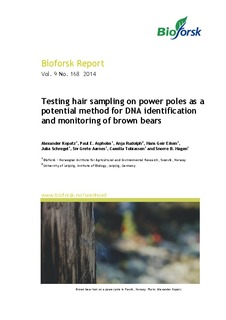| dc.contributor.author | Kopatz, Alexander | |
| dc.contributor.author | Aspholm, Paul Eric | |
| dc.contributor.author | Rudolph, Anja | |
| dc.contributor.author | Eiken, Hans Geir | |
| dc.contributor.author | Schregel, Julia | |
| dc.contributor.author | Aarnes, Siv | |
| dc.contributor.author | Tobiassen, Camilla | |
| dc.contributor.author | Hagen, Snorre | |
| dc.coverage.spatial | Norge, Finnmark, Sør-Varanger, Øvre Pasvik | nb_NO |
| dc.date.accessioned | 2017-08-22T13:30:41Z | |
| dc.date.available | 2017-08-22T13:30:41Z | |
| dc.date.created | 2015-03-04T12:21:03Z | |
| dc.date.issued | 2014-12-05 | |
| dc.identifier.isbn | 978-82-17-01364-8 | |
| dc.identifier.uri | http://hdl.handle.net/11250/2451523 | |
| dc.description.abstract | Genetic methods based on sampling of feces and hairs to study brown bears have become the method of choice for many wildlife researchers and managers. Feces and hairs are the most common sample material for DNA identification of individual bears. While the collection of feces and hairs in the field is carried out in an opportunistic manner, hair-trapping can be applied systematically at specific locations. We have here tested a novel systematic method based on hair sampling on power poles. The method relies on the specific behavior of bears to mark, scratch, bite and scrub on power poles, and by this also leave some hairs behind. During late summer and autumn we have investigated 215 power poles in the Pasvik Valley and sampled 181 hair samples in 2013 and 57 in 2014. A total of 17.3% of the samples collected in 2013 and 12.3% in 2014 were positive on brown bear DNA. Our success rates are comparable to other studies, however, DNA quality/content in the hair samples was generally low. Based on other studies, the method could be improved by sampling during spring and early summer and to use shorter frequencies of 2 to 4 weeks between each sampling. Based on our results and previous studies, we can conclude that this sampling technique should be improved by the development of a more accurate and frequent sampling protocol. Hair sampling from power poles may then lead to improved potential to collect valuable samples and information, which would be more difficult to collect otherwise. | nb_NO |
| dc.language.iso | eng | nb_NO |
| dc.publisher | Bioforsk | nb_NO |
| dc.relation.ispartof | Bioforsk Rapport | |
| dc.relation.ispartofseries | Bioforsk rapport;9(168) 2014 | |
| dc.subject | Brunbjørn | nb_NO |
| dc.subject | Brown bear | nb_NO |
| dc.subject | DNA | nb_NO |
| dc.title | Testing hair sampling on power poles as a potential method for DNA identification and monitoring brown bears | nb_NO |
| dc.type | Research report | nb_NO |
| dc.description.version | publishedVersion | nb_NO |
| dc.subject.nsi | VDP::Naturressursforvaltning: 914 | nb_NO |
| dc.subject.nsi | VDP::Natural resource management: 914 | nb_NO |
| dc.source.pagenumber | 23 | nb_NO |
| dc.source.volume | 9 | nb_NO |
| dc.source.issue | 168 | nb_NO |
| dc.identifier.cristin | 1229361 | |
| dc.relation.project | Bioforsk: 8832 | nb_NO |
| cristin.ispublished | true | |
| cristin.fulltext | original | |
